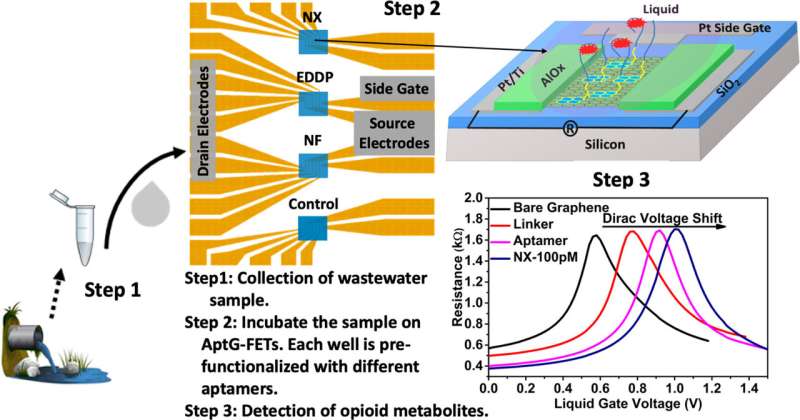
A team of researchers from Boston College, Boston University, and Giner Labs found that the unique properties of the atom-thick sheet of carbon enabled a new penny-sized, multiplexed bio-sensor.
The novel device is the first to use field effect transistors to detect four different synthetic and natural opioids at the same time, while shielding them from wastewater's harsh elements. The electrical charge on the Graphene changes when a specific opioid metabolite is attached to a probe. The signals can be read electronically for each probe.
Boston College Professor of Physics Kenneth Burch is a lead author of the report.
The device responds to the challenge of determining the amount and kind of drugs being used in a community. Privacy concerns and limited resources are obstacles to testing large populations. Wastewater-based epidemiology is similar to testing wastewater to measure community levels of coronaviruses.
Wastewater testing is an emerging strategy that can defeat limitations and stigma associated with individual drug testing, and it provides a more objective measure of drug use at neighborhood level. The portable nature of the team's device would allow wide scale population testing at low cost and high geographical resolution.
The National Institute on Drug Abuse is working with researchers at Giner Labs to develop smart city tools that would assist public health programs addressing drug use and abuse. The National Science Foundation, National Institutes of Health, and the Office of Naval Research provided additional funding for the project.
The prototype could be used by public health officials to determine the level of opiate usage and the impact of community-wide treatment interventions.
The first demonstration that the material could be used with wastewater is the work of the team.
It is the first demonstration of using field effect transistors, an electronic device to read the amount of charge, to detect multiple targets at the same time.
The design and implementation of theGEMS platform enabled the breakthrough. The platform enables the detection of four different targets at the same time, while shielding them from the elements in waste water. Cape Cod has an Alternative Septic System Test Center.
The team fitted the probes with strands of DNA designed to only attach to a specific molecule. The aptamer folds when it is attached to the drug. The amount of charge on the Graphene is monitored to detect the presence of a specific drug.
The design and fabrication of our devices resulted in a lower limit of detection that was better than previous reports.
Sampling tools had limitations because they had to ship samples and test them in a laboratory. The requirements impose costs that limit the use in communities. The device can provide real-time monitoring in multiple locations, which could help distribute resources such as first responders or specific intervention strategies.
The first such sensor that can achieve it with such a simple and easy-to-use setup is a single GEMS platform that is the size of a penny.
The success of GEMS was the result of a long-term collaboration that brought together the expertise of Boston College Associate Professor of Biology Tim van Opijnen, Boston University chemist Xi Ling, and Argun and scientists from Giner Labs.
Additional researchers on the project included Boston College graduate student Michael Geiwitz, research scientist Narendra Kumar, undergraduate Matthew Catalan, and post-doctoral researcher Juan C.
The team was surprised by the device's resilience in the wastewater environment. He said his lab is working with Giner Labs to develop devices for commercial use.
We are working to see what else the platform can be used for, such as rapid at- home testing of viral infections and the presence of pathogens in wastewater.
More information: Narendra Kumar et al, Rapid, Multianalyte Detection of Opioid Metabolites in Wastewater, ACS Nano (2022). DOI: 10.1021/acsnano.1c07094 Journal information: ACS Nano Citation: Graphene sensor rapidly detects opioid metabolites in wastewater (2022, February 25) retrieved 25 February 2022 from https://phys.org/news/2022-02-graphene-sensor-rapidly-opioid-metabolites.html This document is subject to copyright. Apart from any fair dealing for the purpose of private study or research, no part may be reproduced without the written permission. The content is provided for information purposes only.